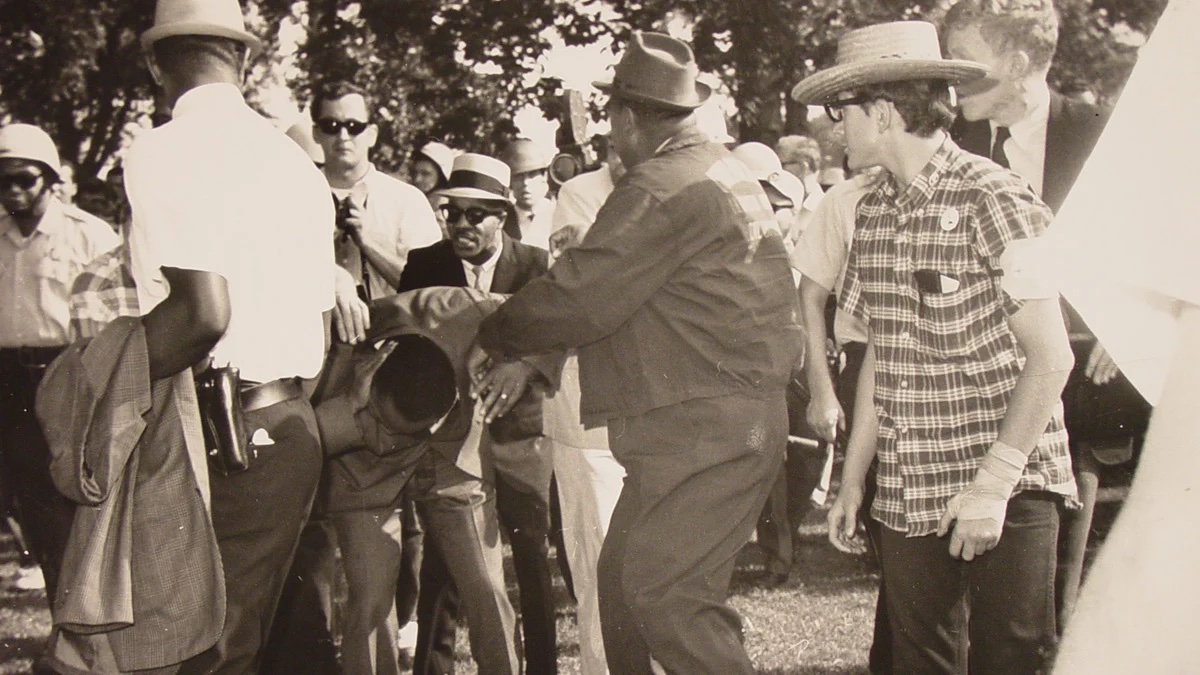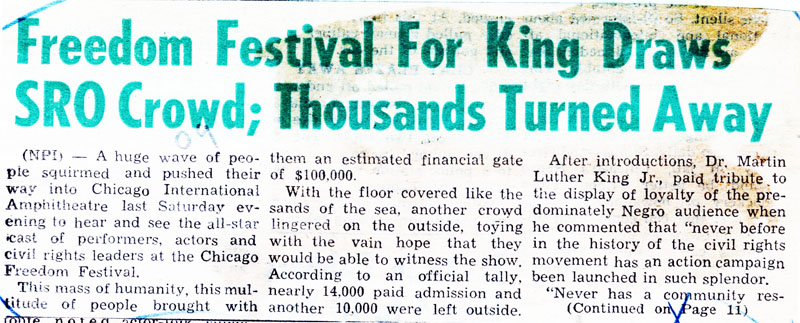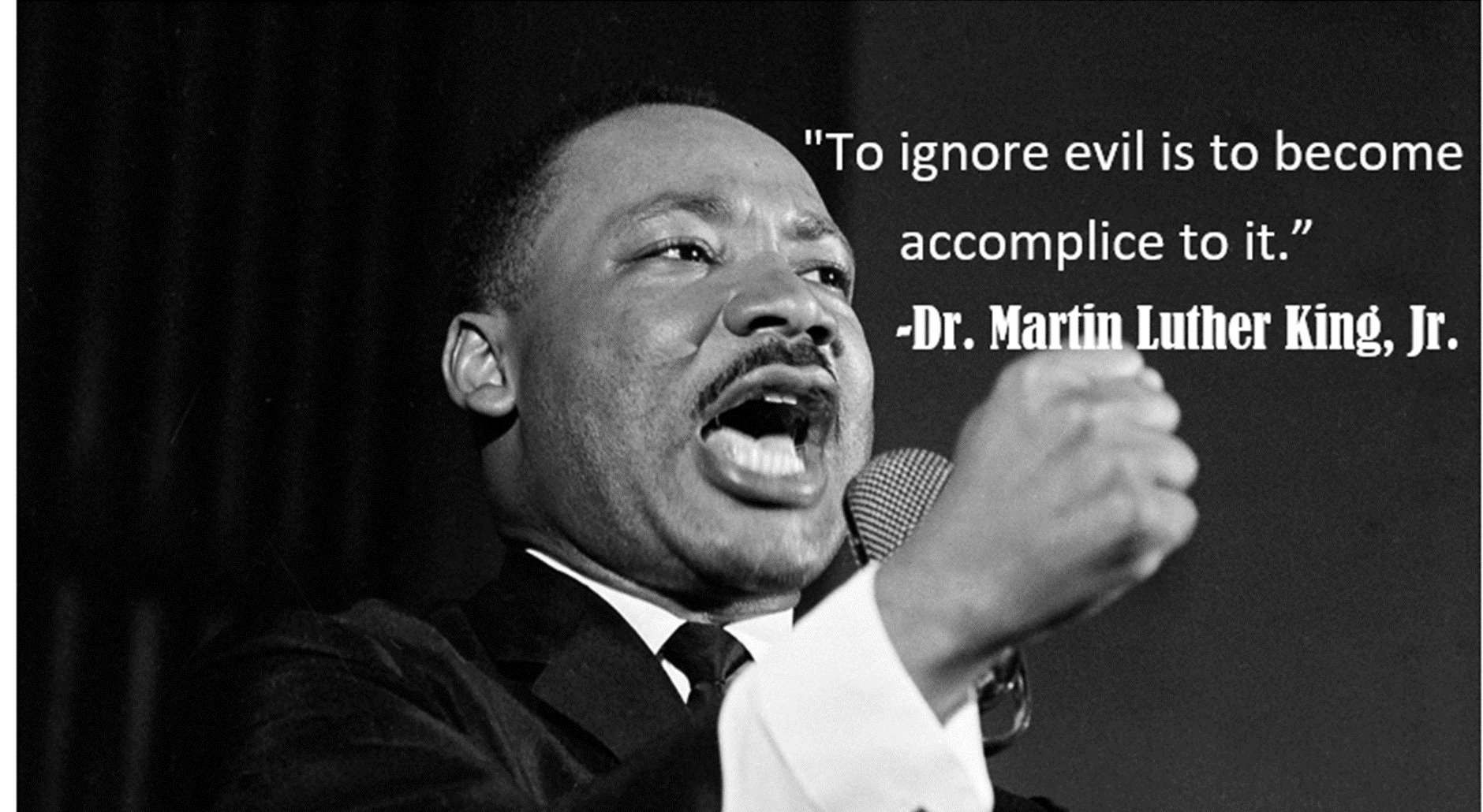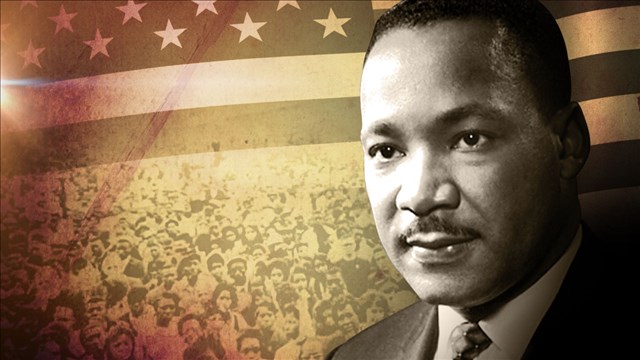Having been invited into the Chicago Freedom Movement led by local leaders such as Al Raby and Edwin C. Bill Berry, Dr. Martin Luther King Jr. gave a speech before hundreds of thousands of people at Soldier Field on July 10, 1966, where he implored Mayor Richard J. Daley to make Chicago a just and open city.
The civil rights icon moved to Chicago’s West Side with his wife Coretta and lived among the people for months in an effort to change the city’s discriminatory housing practices and bring jobs and equity to Blacks throughout the city. Four months before his Soldier’s Field speech, Dr. King addressed the Chicago Freedom Festival, held March 12, 1966, at the Amphitheater on the city’s South Side. It is excerpted below:
On behalf of the Coordinating Council of community organizations and the Southern Christian Leadership Conference, it gives me great pleasure to speak to all of you, who by your presence here tonight have evidenced genuine support for our campaign. And Chicago.
It gives me great pleasure to join with you in this freedom festival, proclaiming the dawn of a new day of dignity and opportunity for the Negro in American cities.
I am happy that my good friends, Mahalia Jackson, Harry Belafonte, Sidney Poitier, and Dick Gregory were able to be with us and share their tremendous reservoir of talent on this occasion. Those who entertain us tonight are the tried-and-true friends of the movement, who have a genuine sense of social concern, and who see their profession as an avenue through which they can contribute to the Negro’s sense of selfhood and to the realization of the promise of democracy.
They have worked with us through the turbulent days of Albany, Birmingham, and Selma and through the dangerous and desolate days of Mississippi, so it is altogether fitting that they should be on hand to support us in the launching of this campaign to remove gargantuan structures of injustice in the North.

Until recently, the concern of the mass nonviolent direct-action arm of the Civil Rights Movement has been focused almost exclusively upon the South. This regional riveting of our attention was due to the fact that it was in the South that the dark clouds of racial injustice had cast their longest shadows; however, in the course of the last decade, the darkness has begun to be dispelled. In spite of the fact that we still have a long, long way to go in the South before justice is a total reality for the Negro, the South is experiencing a new birth of freedom, which comes as a beacon light of hope to millions of disenfranchised people.
In the process, there shines forth a new Negro with a new sense of dignity and destiny, his profile etched in confidence and courage. Armed with his powerful method of non-violent direct action, he has electrified the world, changing embedded customs and provoking historic legislation and giving new meaning to the American dream of freedom.
While the South burst forth with the dynamic vibrancy of New Democracy, the Negro in the North found himself increasingly pressed down by the cruel weight of vicious and discriminatory forces.

The difference between race relations in the North and South is all the more severe since the Negro has increasingly become an urbanized Northerner. Whereas two-thirds of all Negro Americans lived in the 11 states of the Old Confederacy 25 years ago, by 1960, more than 40 percent of the nation’s colored citizens were northern-based.
The Negro has come North, crowding into the confines of already teeming Black ghettos, seeking a promised land. Lured by the promise of a better life, he has found not a land of plenty, but a land replete with poverty. He experienced not the buoyancy of hope, but the fatigue of despair. He found not a promised land, but rather another Egypt land of denial, discrimination, and dismay.
Instead of fulfilling his dreams, the Negro immigrant has found himself mired amid the decay of festering slums on Chicago’s South Side and West Side, in New York’s Harlem, in Detroit’s Paradise Valley and Black Bottom, in Los Angeles’ Watts and in scores of Black Belt communities of the North.
When we look closely at the nature of the slum, we see an urban area that is exploited by the community at large, an area where free trade and exchange of culture and resources are not allowed to exist. In a sense, we are using the word slum interchangeably with what the socialists referred to as the ghetto.
On the one hand, slums include blighted, rat-infested housing conditions. On the other hand, they include all those crippling conditions, which victimize the ghetto Negro: his unemployment, and under-employment, his stifling educational circumstances, his sense of rejection, his sense of aloneness, and his unconscious self-hatred.
The purpose of the slum is to confine those who have no power and perpetuate their powerlessness. In the slum, the Negro is forced to pay more for less, and the general economy of the slum is constantly drained without being replenished. In short, the slum is an invisible wall, which restricts the mobility of persons because of the color of their skin. The slum is little more than a domestic colony, which leaves its inhabitants dominated politically, exploited economically, segregated and humiliated at every turn.
It goes without saying that Chicago has a severe slum problem. The Negro still isn’t getting a square deal in Mississippi, but neither is he getting a square deal in Chicago. The facts are both staggering and revealing.

Chicago has the largest concentration of Negroes in the urban ghetto of any major city in the United States. The Negro, unlike the white urban resident, finds himself and his heirs, even into the third and fourth generation, locked in. He is confined by the conspiratorial noose pulled tight by the racist attitudes and actions of selfish profiteering real estate interests and white residents with their restrictive covenants and ungentlemanly agreements, abetted by the prejudicial practices of mortgage-money lending institutions.
According to the Bureau of the Census in 1960, of the 10 largest cities, Chicago has a greater percentage of substandard housing than any except St. Louis. Forty-one percent of all Negro families in Chicago were reported living in dwellings that were dilapidated, deteriorating, or lacking in plumbing facilities. Negroes are paying $10 a month more than whites for comparable rental units.
At the same time, Negro purchasers paid on an average of $1,500 more than whites when buying houses. On top of that, Negro homebuyers paid higher interest rates on mortgages and contract purchases. In effect, the Negro is forced to pay a color tax while receiving less than whites in quality and service.
But housing is only the beginning of a broad base of exploitation. Racially segregated, slum housing has adverse effects on educational chances for Chicago’s Negro schoolchildren. Slum housing invariably leads to de facto segregated schooling.
Thus, in Chicago, presently, over 90 percent of the colored pupils attend schools that are more than 90 percent Negro. A 1965 analysis of the Board of Education’s own figures show that 92.9 percent of the city’s elementary schools could be classified as de facto segregated. That is, with a racial predominance of more than 90 percent Negro or white. The same study showed that 88.6 percent of the city’s high schools are similarly segregated, with 90 percent of the intermediate grade centers falling into the same category.
Negro schools have a far higher average of non-certified teachers than white schools. Then, too, when there are classroom teacher vacancies, the Negro segregated school is far less likely than the white school to receive a substitute teacher.
A report of the U.S. Civil Rights Commission in 1962 revealed that in Chicago it costs $342 to educate a student in a white school as against $269 in a Negro school. The number of library books available per child in white schools was double that in Negro schools.
All of these aspects of slum education constitute psychological and pedagogic detriments, leading to lowered self-esteem and motivation on the part of the Negro youngsters, lowered academic achievement, higher dropout rates, and as a consequence, more juvenile delinquency, and welfare relief dependency.
The Negro had come North seeking a promised land, which if not flowing with milk and honey, he at least expected to be ladened with jobs and opportunity. It was in the crushing of such dreams that the North has been most cruel to the Negro.
Up and out of the Delta heartland of Dixie, up from Alabama and Mississippi, still, they come pouring in, despite the fact that the stream of jobs which once awaited them has long since dried up. For them, the job opportunities which once were so abundant, have “gone with the wind,” diminishing and disappearing with the precipitous decline in the demand for unskilled labor. …One out of every four Negro families in Chicago finds themselves on welfare rolls. Although the Negro and unemployment rate nationally has remained fairly constant, two times that of whites today in Chicago, it is three times higher than that of the white jobless. This is despite the fact that Chicago constitutes one of the most prosperous commercial centers in the nation, according to the latest Department of Labor Statistics.
Yes, the Chicago Negro and the northern Negro generally find themselves urban peasants, impoverished aliens in an affluent society. He is too poor even to rise with the society; too impoverished by the ages to be able to ascend by using his own resources. If the remainder of the nation’s workforce were undergoing the same dire plight as is the Negro, today, our country would be caught in the grips of a staggering depression.
While the rest of the nation’s economic temperature dips up and down between glowing prosperity and slight recession, the mercury of the Negro’s economic thermometer freezes, having registered chilliest depression.
Presently, there’s an army of 60,000 unemployed Negro males seeking jobs in Chicago. That total would certainly approach 100,000 if one includes the discouraged, the ones who have given up every hope and who are no longer looking for jobs. Such of the forlorn have long ago been turned back too many times by doors slammed in their faces, turned back too many times by the “I’m sorry, there’s nothing today for you. Don’t call us, we’ll call you.” Turned back too many times and being “the last hired and the first fired.”
Psychologically, such Negroes are the ill-starred and deeply wounded veterans of what can be called “slum shock.” They are the victims of that which my friend, Edwin Berry, of the Urban League, has labeled “cultural castration.” They end up saying unconsciously in the words of Paul Laurence Dunbar: “a crust of bread and a corner to sleep in, a minute to smile and an hour to weep in, a pint of joy to a peck of trouble, and never a laugh that the mourns come double, and this is life.”
Slum shock, then, is the psychological response of the beaten, the bruised, and the oppressed. The Chicago movement in slums comes, just as did the Civil Rights Movement in the South, to give the Negro new dignity, new self-respect, and new power. It comes to provide an opportunity for the long-neglected children of God to speak for themselves, to tell of their anguish, their desperation, their discontent, and to force those in positions of power to act.
Given our present understanding of the nature of slums, what then are the challenges we face? Time will not permit me to outline our program of action, but it is clear to me that we must organize this total community into unities of political and social power. We must also reaffirm our allegiance to the time-honored tactics and strategies that have served us so well in the past 10 years.
As long as injustice is around, demonstrations will be necessary. So, when it is appropriate, we will encourage citywide rent strikes, boycotts, picket lines, marches, civil disobedience, and any form of protest and demonstrations that are non-violently conceived and executed.
At the same time, we recognize that the right of assembly and protest is a relative right subject to the regulations to protect the rights of others. For that reason, before a protest can be approved by responsible leadership, they must answer the following questions:
…I know that you have often been tempted to strike out in revenge against white people for the many wrongs perpetrated against you and yours. I know that you have long wanted to lash out at your opponent to let them know that you are not a nobody, that you are a human capable of being hurt, scarred, and bruised. I know that you have been tempted to take up the torches, and do as did the slum tenants of Los Angeles, who lit the fires of Watts, scorching the national conscious indelibly with their seething resentment and smoldering frustration.
But let me remind you that there are many white men and women who are friends, many who have suffered and sacrificed and died with us as we struggled to bring true freedom and democracy to our beloved land. We must never forget that it was a white mother from Michigan, named Viola Liuzzo, who went South to Selma to march with us and who was shot down in the dark of the night on Alabama’s Highway 80. We must not forget that it was a young Episcopalian seminarian named Jonathan Daniels who worked with us in voter registration in Lowndes County, Alabama, and who then gave his life on freedom’s altar, while beside him was wounded a Catholic priest, Father Morrisroe, from this very city, Chicago.
We must never forget that there were once two Jewish lads, Michael Schwerner and Andrew Goodman, from New York, who gave their lives for freedom along with a Black friend, in Mississippi.
With such valiant martyrs in mind, let me call you away from the bitterness of bigotry, back to love and reconciliation, reminding you that such great souls were truly our friends. For even as Jesus has said, “Greater love than this has no man, that he should lay down his life for a friend.”
So, I want to call you to a path of love and justice, the path of nonviolent direct action. For I am still convinced that the philosophy and practice of nonviolence affords a more excellent way to improve the inadequacies in the American social system. The method of nonviolent resistance is effective in that it has a way of disarming the opponent. It exposes his moral defenses, it weakens his morale, and at the same time, it works on his conscience.
What did Watts accomplish, but the death of 34 Negroes and injury to thousands more? What did it profit the Negro to burn down the stores and factories in which he sought employment? The way of riots is not the way of progress, but a blind alley of death and destruction, which wreaks its havoc hardest against the rioters themselves.
But nonviolent resistance provides a creative force through which men can channel their discontent. It does not require that they abandon their discontent. This discontent is sound and healthy. The beauty of nonviolence is that it says that you can struggle without hating. You can fight without violence. It says that an organized cadre of dedicated souls possesses more power than Molotov cocktails or atom bombs.
It is my hope that as the urban Negro plunges deeper into the quest for freedom, he will plunge even deeper into the philosophy of nonviolence.
As a race, we must work passionately and unrelentingly for first-class citizenship. But we must never use second-class methods to gain it. We must never succumb to the temptation of using violence in the struggle. For if this happens, unborn generations will be the recipients of a long and desolate night of bitterness, and our chief legacy to the future will be an endless reign of meaningless chaos.
Let me also appeal to our brothers of the white community for support in this monumentally significant movement against the slums.
There can be no lasting escape for those of you who have fled behind the suburban curtain, for your Black brother yet languishes in the slums crying out to you. Your lot is inextricably interwoven with his since he retains the capability of bringing down the curtain on the American Dream. A minority that is sick with despair can poison the wellsprings from which the majority, too, must drink.
The answer to the staggering problems that we face in Chicago is to be found in the grand alliance of the forces of goodwill with the underprivileged to end the dark days of powerless existence. For, in reality, the slum is a community without the power to determine its own destiny, a domestic colony which, though taxed, has no representation in fact. Decisions are handed down to them and they live at the mercy and bounty of the people with real power, either politically or economically.
What is needed is the power of the people organized in community groups and around action projects as a third force to bring to bear their power on the prevailing power elite. Only as this non-partisan moral force speaks its voice, can we be sure that a truly democratic government survives in our cities.
We saw this happen nationally around Birmingham. Churches, labor, and intellectuals rallied together against the structured brutality of southern racism, as exemplified in Bull Connor and in his dogs, and change took place to reshape the structure of the South in the architecture of justice.
Now a pattern of economic exploitation still exists in our northern cities, and it could be every bit as tragic and vicious as Bull Conner and the Ku Klux Klan. We can put an end to children dying of rat bites or catching pneumonia from un-heated buildings because the courts find it fitting to give the landlord a 30-day extension to fix the furnace.
The forces of goodwill in the churches and in the labor movement have already come forth and pledged themselves as allies in this struggle. And there’s evidence that the leaders of the business community are beginning to understand that they have nothing to gain through swollen welfare rolls, unemployment, and children finishing high school reading at a sixth-grade level.
These problems are a drain on our whole society, and we must join together now to effect a grand alliance for social reform of our cities in a controlled nonviolent pattern, lest the Holocaust of frustration and bitterness destroy the very values which we cling to in fear.
These then, are the basic issues that our movement must face. This is the road we must travel from this juncture in our ongoing struggle. Let us, therefore, resolve to be engaged in a sort of divine dissatisfaction until the American Dream is a reality.
Let us be dissatisfied until every socially oppressive ghetto and rat-infested slum is plunged into the junk heaps of our nation and Negroes and whites live side by side in decent, safe, and sanitary housing. Let us be dissatisfied until every vestige of segregated and inferior education will become a thing of the dark past, and Negro and white children study side by side in a socially healing context of the classroom.
Let us be dissatisfied until all the men will have food and material necessary for their business; culture and education for their minds; freedom and dignity for their spirits. Let us be dissatisfied until every hand-cuff of poverty is unlocked and work-starved men will no longer walk the streets in search of jobs that don’t exist. Let us be dissatisfied until wrinkled stomachs in Mississippi are filled until the idle industries of Appalachia are revitalized and until broken lives in sweltering ghettos are mended and remodeled.
Let us be dissatisfied until race-baiters disappear from the political arena: until the Wallaces and Eastlands tremble away into silence; until brotherhood becomes more than a meaningless word in an opening prayer, but the order of the day on every legislative agenda.
Let us be dissatisfied until the sacred Halls of Congress are filled with men who will do justly, love mercy, and walk humbly with their God. Let us be dissatisfied until men everywhere will be imbued with a passion for justice until the Lion and the Lamb will lie down together and every man shall sit under his own vine and fig tree and none shall be afraid.
The road ahead will not always be smooth. There will still be rocky places of frustration and meandering points of bewilderment. There will be inevitable setbacks here and there, and sunlit paths of hope will at times be transformed into dark and desolate valleys of despair.
Our dreams will sometimes be shattered, and our ethereal hopes blasted. We may again, with tear-drenched eyes, have to stand before the bier of some courageous civil rights worker whose life will be snuffed out by the dastardly actions of bloodthirsty mobs. But difficult and painful as it is, we must walk on in the days ahead with an audacious faith in the future.
And as we continue our chartered course, we may gain.






